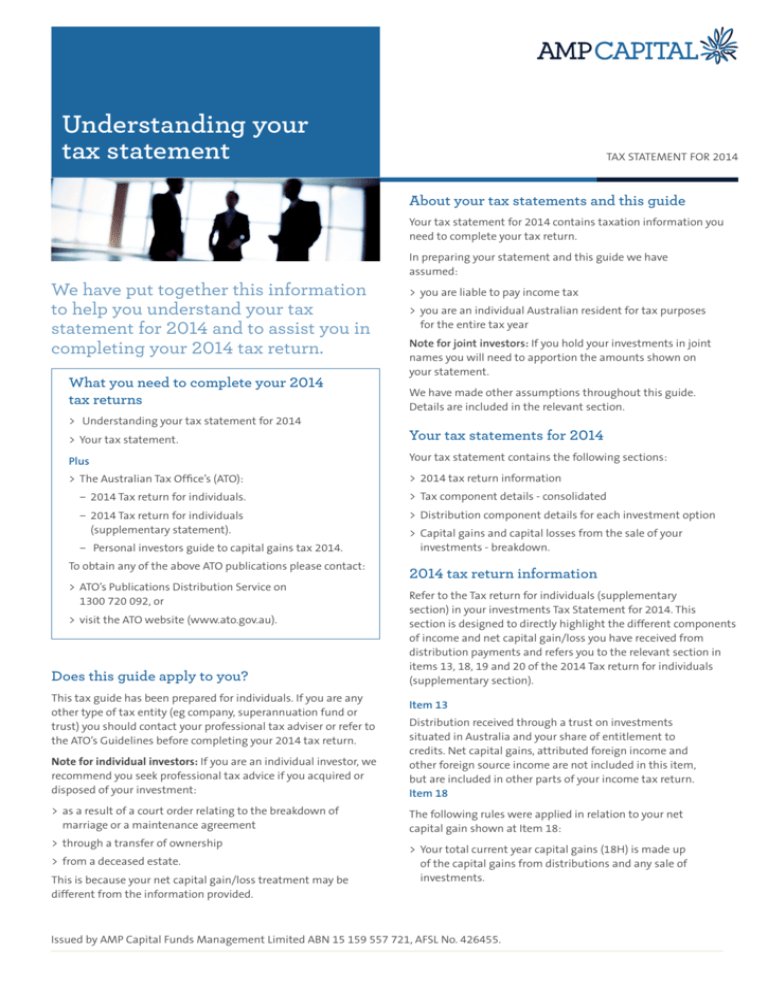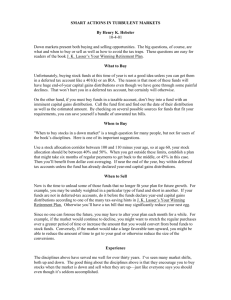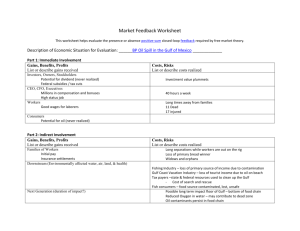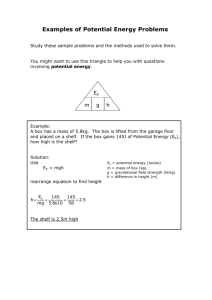A guide to your annual tax statement
advertisement

Understanding your tax statement TAX STATEMENT FOR 2014 About your tax statements and this guide Your tax statement for 2014 contains taxation information you need to complete your tax return. In preparing your statement and this guide we have assumed: We have put together this information to help you understand your tax statement for 2014 and to assist you in completing your 2014 tax return. What you need to complete your 2014 tax returns >> Understanding your tax statement for 2014 >> you are liable to pay income tax >> you are an individual Australian resident for tax purposes for the entire tax year Note for joint investors: If you hold your investments in joint names you will need to apportion the amounts shown on your statement. We have made other assumptions throughout this guide. Details are included in the relevant section. >> Your tax statement. Your tax statements for 2014 Plus Your tax statement contains the following sections: >> The Australian Tax Office’s (ATO): >> 2014 tax return information −− 2014 Tax return for individuals. >> Tax component details - consolidated −− 2014 Tax return for individuals (supplementary statement). >> Distribution component details for each investment option −− Personal investors guide to capital gains tax 2014. To obtain any of the above ATO publications please contact: >> ATO’s Publications Distribution Service on 1300 720 092, or >> visit the ATO website (www.ato.gov.au). Does this guide apply to you? This tax guide has been prepared for individuals. If you are any other type of tax entity (eg company, superannuation fund or trust) you should contact your professional tax adviser or refer to the ATO’s Guidelines before completing your 2014 tax return. >> Capital gains and capital losses from the sale of your investments - breakdown. 2014 tax return information Refer to the Tax return for individuals (supplementary section) in your investments Tax Statement for 2014. This section is designed to directly highlight the different components of income and net capital gain/loss you have received from distribution payments and refers you to the relevant section in items 13, 18, 19 and 20 of the 2014 Tax return for individuals (supplementary section). Item 13 Note for individual investors: If you are an individual investor, we recommend you seek professional tax advice if you acquired or disposed of your investment: Distribution received through a trust on investments situated in Australia and your share of entitlement to credits. Net capital gains, attributed foreign income and other foreign source income are not included in this item, but are included in other parts of your income tax return. Item 18 >> as a result of a court order relating to the breakdown of marriage or a maintenance agreement The following rules were applied in relation to your net capital gain shown at Item 18: >> through a transfer of ownership >> from a deceased estate. This is because your net capital gain/loss treatment may be different from the information provided. >> Your total current year capital gains (18H) is made up of the capital gains from distributions and any sale of investments. Issued by AMP Capital Funds Management Limited ABN 15 159 557 721, AFSL No. 426455. >> In calculating your net capital gain or loss (18A or 18V), we have assumed the following order to offset your capital losses against capital gains: −− Capital gains - other method −− Capital gains - indexation method −− Capital gains - discount method (grossed up method). Other non-assessable amounts Includes any other income that is not subject to income tax: >> Tax deferred income is attributable to depreciation of assets and other allowances. Tax deferred income is deducted from the cost base of your investment when you are calculating capital gains and capital losses. Note: We have also assumed that you have not carried forward capital losses. If you have, please refer to the ATO’s Personal investors guide to capital gains tax or contact your professional tax adviser. >> Tax free income arises from infrastructure borrowings and certain other types of exempt income. Tax free income is deducted from the cost base of your investment only when you are calculating capital losses. Item 19 >> Tax exempted income generally arises from the receipt of certain foreign income. Tax exempted income has no effect on the cost base of your investment. Attributed foreign income from any indirect controlled foreign company or foreign investment fund distributed through a trust. Item 20 >> Return of capital is treated as tax deferred income. Tax deferred income is deducted from the cost base of your investment when you are calculating capital gains/losses. An amount will be shown if your investment option distributed foreign interest, dividends or other foreign source income net Note: We have made these adjustments to the cost base when calculating your capital gains and capital losses. Tax component details - consolidated If you have not provided us with your Tax File Number (TFN) or Australian Business Number (ABN) or exemption we have deducted tax at the top marginal rate from your distributions and paid this to the ATO. Generally you will be able to offset this tax paid against your assessable income, or a refund when you lodge your tax return. This section provides a summary of distribution payments (by component) you have received for the financial year. For details of this information by investment option, please refer to the section Distribution component details - for each investment option. Note: Your statement includes distributions that were declared for the 2013/14 financial year (but not necessarily paid in the financial year). Australian income Includes franked dividends, unfranked dividends, interest and other income - net of deductions such as bank charges and expenses deducted by the fund manager. Capital Gains from distributions Capital gains derived by the sale of assets in each investment option. In certain situations, the capital gain can be calculated using the discount or indexation method. For your personal net capital gain/loss from the sale of your investments - refer to the Capital gains and capital losses from sale of your investments breakdown section in the tax statement. Foreign income Arises when investment options distribute foreign interest, dividends or other foreign source income net of relevant deductions. TFN (or withholding tax) amounts deducted If you are a non-resident taxpayer we have deducted tax from your distributions at the relevant withholding tax rate. Franking credits These are tax credits received from Australian shares and represent tax already paid by a company on its profits. As a general rule, franking credits equal the franked dividend amount multiplied by 30 divided by 70. However, where deductions and expenses are offset against franked dividends, the Trustee must decide the order in which expenses are offset against the different types of trust income. Where the expenses are offset against franked dividends, you may still be entitled to a tax offset equal to the full amount of the franking credits shown in your tax statement. If you require further information, you should talk to your professional tax adviser. Legislation may stop you claiming franking credits in certain circumstances if you have not held your units for a requisite period of time. You should talk to your professional tax adviser to confirm if you are eligible to claim the franking credits shown in your tax statement. Foreign income tax offsets These are tax credits from overseas investments where foreign tax has been paid on the income or capital gains from those investments. You may be able to apply these offsets against your tax liability, up to a limit equal to the lower of the foreign tax paid and the Australian tax payable. You should contact your professional tax adviser for advice on whether you can use these foreign income tax offsets. Capital gains - discount method (grossed up) Notes Capital gain - discount method (grossed up) is your capital gain before any discount is applied. Capital Gains Tax Special rebates This includes any Management Fee rebate and/or Planner Servicing Rebates you received. These rebates are classed as other Australian income for tax purposes. TFN deducted - special rebates If you have not provided your TFN, ABN (or exemption), or you are a non-resident taxpayer, we have deducted tax and paid it to the ATO from any Management Fee rebate and/or Planner Servicing rebates you received. Capital Gains Tax (CGT) is a tax on the growth in the value of your investments, which is payable when you trigger a CGT event such as sale of units (including switching investment options). You may also receive a distribution of capital gains from the investment option you invest in (even if you reinvest your distribution payments). A capital loss occurs from a CGT event when the capital proceeds you receive is less than the reduced cost base (what you paid for it). If you made a capital loss If you are a resident taxpayer, generally you will be able to offset this tax paid against your assessable income when you lodge your tax return. We have made the necessary adjustments to the cost base taking into account tax deferred and tax free income and any return of capital amounts received. Capital gains and losses from the sale of your investments - breakdown If you made a capital gain You may have incurred capital gains/losses during the year if you have sold units. Units are sold if you: >> make a full or partial withdrawal >> have a Regular Withdrawal Plan >> If you acquired units before 21 September 1999, and you held those units for more than 12 months, you can use either the capital gains - indexation method or capital gains - discount method. We have used the most favourable capital gain method available to you for each CGT event disclosed on your statement. For details on the Capital Gains Tax method we have applied, please refer to the Notes and Frequently Asked Questions section at the end of this guide. >> If you acquired units on or after 21 September 1999, and you held those units for more than 12 months, we have applied the capital gains - discount method. This is the only method available to you. The amounts shown are “grossed up” – this means we have shown these figures before the 50% discount is applied. Note: We have assumed that you do not hold your investments as trading stock and that you did not acquire them in circumstances where any profit on disposal would be assessable as ordinary income. >> If you acquired units on or after 21 September 1999, and you held those units for less than 12 months, we have applied the capital gains - other method. This is the only method available to you. If you have, you should talk to your professional tax adviser. If this account was transferred to you due to the death of the original account holder >> switched investment options >> have paid planner servicing fees. The information provided in the ‘Capital gains and losses from sale of your investments – breakdown’ section has been calculated for individual Australian tax residents. If you are a non-resident for Australian tax purposes and have withdrawn units during the 201/1 financial year, we recommend you obtain professional tax advice, as your net capital gain/loss treatment may be different. Please be aware that any withdrawals within 12 months of the date of death will not be eligible for the 50% discount applicable to calculations of the Capital Gain using the discount method. All withdrawals after this 12 month period will be eligible for the 50% discount. Please refer to your professional tax adviser for further information. Note: There will be some situations where there is no capital gain or capital loss on the sale of your investments. This occurs if the sale proceeds are less than the nominal/ indexed cost base, but more than the reduced cost base. Supplementary notes for non-residents of Australia If you are a non-resident for Australian tax purposes, the following components affect the amount of withholding tax deducted from your distribution. These additional components have been included in your Tax Statement for 2014 under the section Tax component details - consolidated. Australian income - dividends unfranked Conduit Foreign Income This relates to any part of unfranked dividends paid by an Australian corporate tax entity that it declares to be Conduit Foreign Income (CFI). If you are a non-resident for tax purposes, you are not required to pay Australian tax on unfranked CFI dividends. TARP and NTARP Capital gains TARP (Taxable Australian Real Property) are capital gains from assets owned by a non-resident of Australia, which are subject to CGT in Australia. Withholding tax is deducted from such gains. Capital gains NTARP (Non-Taxable Australian Real Property) represent gains on assets in which non-residents are not subject to CGT. Frequently asked questions Important: The following information is provided as a general guide only. We recommend you discuss your personal situation with your professional tax adviser. Can I claim a tax deduction for management fees and contributions fees? Management fees have already been deducted from distributed income and reflected in the unit prices. Management fees are treated as a deductible expense included in the calculation of taxable income in the tax statement. Contribution fees are not tax deductible. If I have not sold any units, why do I have capital gains? Part of each distribution payment you receive may contain a capital gains component (even if you reinvest your distribution payments). If you have not sold any units you may still need to pay CGT. What do I do, if my investment is held in more than one name? If the investment is held in two or more names, you will need to apportion amounts of all income, tax credits, capital gain, etc. Each investor will need to declare these amounts in their individual tax return. What are the different methods used to calculate capital gains or loss? There are three ways of calculating capital gains or losses: >> Indexation method - this method allows an increase in the cost base by applying an indexation factor that is based on the Consumer Price Index (CPI) up to September 1999. This method is applied to assets held for 12 months or more and acquired before 11.45am on 21 September 1999. >> Discount method - if you held your assets for more than 12 months, this method allows you to reduce your capital gain (after subtracting any capital losses) by applying a 50% discount. >> Other method - When the indexation and discount methods do not apply and your assets were bought and sold within 12 months. Capital gains and losses are calculated by subtracting the cost base from the capital proceeds. Should I include Management Fee rebates and Planner Servicing rebates in my tax return? These rebates are considered assessable income and have already been included (where applicable) in the amount shown as Non-primary production income in your tax statement. Management Fee and Planner Servicing rebates are also shown separately as Special rebates under the section Other Information. Can I claim a tax deduction for Planner Servicing Fees? Under some circumstances you may be able to claim Planner Servicing Fees paid as a tax deduction. The amount you can claim will depend upon your circumstances and the nature of the services provided by your planner. We recommend that you seek professional tax advice. Contact us If you would like to know more about how AMP Capital can help you, please visit ampcapital.com.au, or contact one of the following: Responsible entity: National Mutual Funds Management Ltd ABN 32 006 787 720 AFS Licence No. 234652 Important note: This publication has been prepared to provide general information only and does not take into account the financial objectives, situation or needs of any particular person. It is not intended to take the place of professional advice and you should not take action on specific issues in reliance on this information. Before making an investment decision, you need to consider (with or without the assistance of an adviser) whether this information is appropriate to your needs, objectives and circumstances. Past performance is not necessarily indicative of future performance. Detailed information about the product is contained in the PDS. Applications for investment in the product will only be accepted on receipt of an application form accompanying a current PDS. A copy of the PDS can be obtained by calling 137 292. National Mutual Funds Management Ltd and its associates derive income from issuing interests in the product, full details of which are contained in the PDS. Unless specifically stated, the repayment of capital or performance of our products is not guaranteed. This information is provided for persons in Australia only and is not provided for the use of any person who is in any other country. ... AMP Capital Investors Limited GPO Box 2780 Melbourne VIC 3001 Telephone: 1800 780 085 Facsimile: (03) 8688 5796 client.inquiry@ampcapital.com






